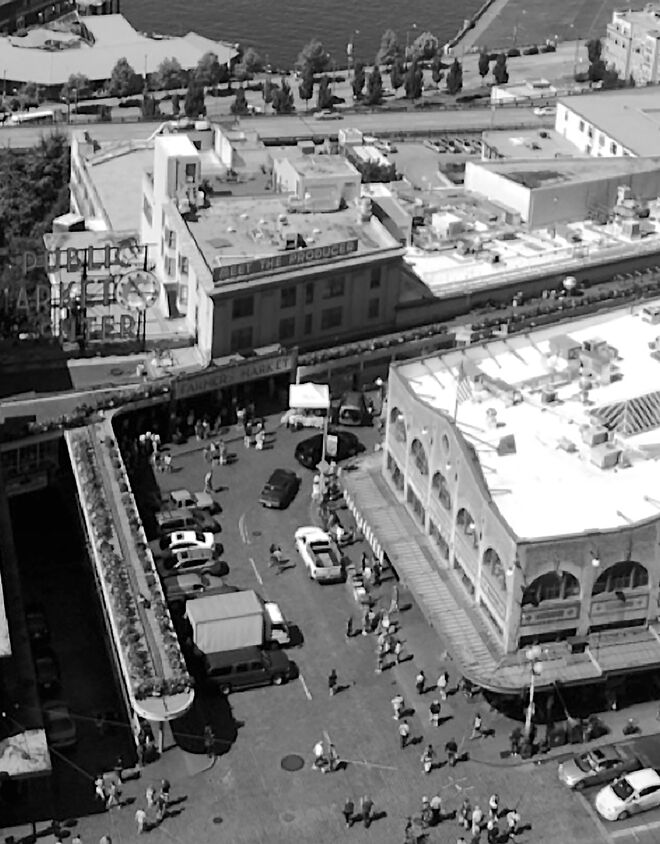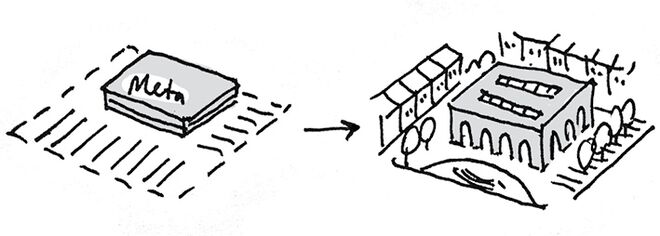5.2. Market Center
Aus Pattern Language Wiki
Along the active edges of a Pedestrian Sanctuary, where the demand for market centers is significant, and transit service and mobility are highest, create integrated complexes of buildings that serve as market centers.
Problem-statement: Shopping is one of the most fundamental activities of daily life, and it should be accessible, convenient, safe and attractive. It should not be allowed to destroy the quality and pedestrian scale of the surrounding neighborhood.
Discussion:: Too often, shopping centers have been allowed to grow monstrous, and create urban dead zones at their edges: parking lots, concentrated vehicular arterials, and other disruptions. This is unnecessary. A market center can be successfully integrated with the surrounding pedestrian fabric, by providing multiple blocks connected by subterranean levels and bridges.
The original plan for shopping “malls” came from the architect Victor Gruen, who was — ironically — seeking to reproduce the car-free ambience of European village squares. Of course, nearby residents pay a heavy price, for the edges of these inward-turning megastructures draw the life from their surroundings, and create large dead zones within the urban fabric — either ugly and unecological parking lots, or inactive streets, or both.
The final irony is that enclosed shopping malls are becoming much less popular, and buyers increasingly crave real streets with vibrant activities. In response, some shopping mall developers have created “lifestyle malls” built around open streets, only some of which are pedestrian-only. This is a step in the right direction — although any market center will thrive on adjacency and mix, rather than a segregated monoculture of whatever kind.¹
Therefore:
Do not build gigantic, isolated shopping “malls”, which are cut off from the urban fabric surrounding them, and damaging to it. Instead build lively market centers, allowing different buildings to span over (or even under) the street network.
Assure that the edges of the centers have a Walkable Streetscape. Articulate these spaces, and the spaces within, with a Place Network…
¹ See for example Southworth, M. (2005). Reinventing main street: From mall to townscape mall. Journal of Urban Design, 10(2), 151-170.
Mehaffy, M. et al. (2020). MARKET CENTER (pattern). In A New Pattern Language for Growing Regions. The Dalles: Sustasis Press. Available at https://pattern-language.wiki/.../Market_Center
SECTION I:
PATTERNS OF SCALE
1. REGIONAL PATTERNS
Define the large-scale spatial organization…
1.4. 400M THROUGH STREET NETWORK
2. URBAN PATTERNS
Establish essential urban characteristics…
3. STREET PATTERNS
Identify and allocate street types…
4. NEIGHBORHOOD PATTERNS
Define neighborhood-scale elements…
5. SPECIAL USE PATTERNS
Integrate unique urban elements with care…
6. PUBLIC SPACE PATTERNS
Establish the character of the crucial public realm…
7. BLOCK AND PLOT PATTERNS
Lay out the detailed structure of property lines…
8. STREETSCAPE PATTERNS
Configure the street as a welcoming place…
9. BUILDING PATTERNS
Lay out appropriate urban buildings…
10. BUILDING EDGE PATTERNS
Create interior and exterior connectivity…
10.1. INDOOR-OUTDOOR AMBIGUITY
SECTION II:
PATTERNS OF MULTIPLE SCALE
11. GEOMETRIC PATTERNS
Build in coherent geometries at all scales…
11.2. SMALL GROUPS OF ELEMENTS
12. AFFORDANCE PATTERNS
Build in user capacity to shape the environment…
13. RETROFIT PATTERNS
Revitalize and improve existing urban assets …
14. INFORMAL GROWTH PATTERNS
Accommodate “bottom-up” urban growth…
15. CONSTRUCTION PATTERNS
Use the building process to enrich the result…
SECTION III:
PATTERNS OF PROCESS
16. IMPLEMENTATION TOOL PATTERNS
Use tools to achieve successful results…
16.2. ENTITLEMENT STREAMLINING
16.3. NEIGHBORHOOD PLANNING CENTER
17. PROJECT ECONOMICS PATTERNS
Create flows of money that support urban quality…
17.4. ECONOMIES OF PLACE AND DIFFERENTIATION
18. PLACE GOVERNANCE PATTERNS
Processes for making and managing places…
18.3. PUBLIC-PRIVATE PLACE MANAGEMENT
19. AFFORDABILITY PATTERNS
Build in affordability for all incomes…
19.1. INTEGRATED AFFORDABILITY
20. NEW TECHNOLOGY PATTERNS
Integrate new systems without damaging old ones…
20.2. RESPONSIVE TRANSPORTATION NETWORK COMPANY


